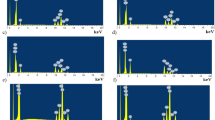Abstract
In this work, we have discussed the transition of glass to a softened (viscous) state as a result of simultaneous impacts of temperature and mechanical stresses. This approach allows describing the temperature dependence of the microhardness of glass below the glass transition temperature and substantiates the previously suggested functional relationship of these two parameters. As an illustration, the proposed model is applied to a classical chalcogenide glass, namely to glassy selenium and glasses based on glassy selenium. Important result lies in the fact that the relationship between the microhardness and enthalpy of glasses is established.




Similar content being viewed by others
REFERENCES
Sharma, R., Welch, R.S., Kang, M., Goncalves, C., Blanco, C., Buff, A., Fauvel, V., Loretz, T., Rivero-Baleine, C., and Richardson, K., Impact of morphology and microstructure on the mechanical properties of Ge–As–Pb–Se glass ceramics, Appl. Sci., 2020, vol. 10, 2836.
Bar, A.K., Kar, T., Royan, D., Bhattacharya, S., Vickers micro hardness measurement of GlassNanoco, J. Mater. Sci. Mech. Eng., 2014, vol. 1, no. 1, pp. 18–22.
Kugler, S. and Shimakawa, K., Amorphous Semiconductors, Cambridge: Cambridge Univ. Press, 2015.
Freitas, J., Shimakawa, K., and Kugler, S., Some remarks on the glass-transition temperature in chalcogenide glasses: A correlation with the microhardness ruben, Chalcogenide Lett., 2013, vol. 10, pp. 39–43.
Sanditov, D.S. and Badmaev, S.S., Delocalized-atom model and properties of sulfophosphate glasses, Inorg. Mater., 2019, vol. 55, pp. 90–95.
Balta Calleja, F.J., Sanditov, D.S., and Privalko, V.P., Review: The microhardness of non-crystalline materials, J. Mater. Sci., 2002, vol. 37, pp. 4507–4516.
Fakirov, S., The relationship between the microhardness and glass transition temperature of inorganic glasses compared with polymeric glasses, Int. J. Polym. Mater. Polym. Biomater., 2005, vol. 54, pp. 1185–1189.
Balta Calleja, F.J. and Krumova, M., On the relationship between microhardness and glass transition temperature of some amorphous polymers, J. Polym. Sci. B: Polym. Phys., 1999, vol. 37, pp. 1413–1419.
Slouf, M., Strachota, B., Strachota, A., Gajdosova, V., Bertschova, V., and Nohava, J., Macro-, micro- and nanomechanical characterization of crosslinked polymers with very broad range of mechanical properties, Polymers, 2020, vol. 12, no. 12, 2951.
Tveryanovich, Yu.S., On the correlation of the microhardness and softening temperature for chalcogenide glasses, Glass Phys. Chem., 2022, vol. 48, pp. 72–74.
Borisova, Z., Glassy Semiconductors, Boston, MA: Springer, 1981, p. 505.
Kasap, S.O. and Yannacopoulos, S., Mechanical and thermal properties of the glassy semiconductor chlorinated Se0.997As0.003 used as an X-ray imaging material, Can. J. Phys., 1989, vol. 67, pp. 686–693.
Le Bourhis, E., Gadaud, P., Guin, J.-P., Toutnerie, N., Zhang, X.H., Lucas, J., and Rouxel, T., Temperature dependence of the mechanical behavior of a GeAsSe glass, Scr. Mater., 2001, vol. 45, pp. 317–323.
Gaur, U., Shu, H.-C., Mehta, A., and Wunderlich, B., Heat capacity and other thermodynamic properties of linear macromolecules. I. Selenium, J. Phys. Chem., 1981, vol. 10, pp. 89–117.
Minaev, V.S., Parfenov, N.M., Timoshenkov, S.P., Kalugin, V., Batyunya, L.P., and Mukimov, D.Zh., Polymer-polymorphoid nature of the glass aging process, Mater. Electron. Technol., 2014, vol. 17, pp. 17–23.
Guin, J.-P., Rouxel, T., Keryvin, V., Sangleboeuf, J.-Ch., Serre, I., and Lucas, J., Indentation creep of Ge-Se chalcogenide glasses below Tg: Elastic recovery and non-newtonian flow, J. Non-Cryst. Solids, 2002, vol. 298, pp. 260–269.
Rao, V., Mehta, N., Kumar, A., and Dwivedi, D.K., Effect of Sb incorporation on thermo-mechanical properties of amorphous Se–Te–Sn alloys, Mater. Res., 2018, vol. 5, no. 6, 065206.
Xinyu Huang, Qing Jiao, Changgui Lin, Erwei Zhu, Xueyun Liu, Shixun Dai, and Tiefeng Xu, Formation, microstructure, and conductivity of a novel Ga2S3-Sb2S3-AgI chalcogenide system, Sci. Rep., 2018, vol. 8, 1699.
Zhuobin Li, ChangguiLin, GuoshunQu, LaurentCalvez, ShixunDai, Xianghua Zhang, Tiefeng Xu, and Qiuhua Nie, Formation and properties of chalcogenide glasses based on GeS2-Sb2S3-AgI system, Mater. Lett., 2014, vol. 132, pp. 203–205.
Malesh, V.I., Rubish, V.V., Shpak, I.I., Rubish, V.M., and Puha, P.P., Polarization properties and a local structure of (GeSe2)x(Sb2Se3)1 – x glasses, Semicond. Phys., Quantum Electron. Optoelectron., 2002, vol. 5, no. 4, pp. 385–390.
Giridhar, A., Narasimham, P.S.L., and Mahadevan, S., Density and microhardness of Ge-Sb-Se glasses, J. Non-Cryst. Solids, 1981, vol. 43, pp. 29–35.
Jun Ho Lee, Hyun Kim, Ji In Lee, Se Young Ko, Ju Hyeon Choi, and Yong Gyu Choi, Infrared transmission and refractive index dispersion of mixed-chalcogen Ge–Sb–S–Se glasses for use in molded lens applications, J. Non-Cryst. Solids, 2020, vol. 546, 120258.
Funding
This research was supported by the Russian Foundation for Basic Research, project no. 20-03-00185.
Author information
Authors and Affiliations
Corresponding author
Ethics declarations
The author declares that he has no conflicts of interest.
Rights and permissions
About this article
Cite this article
Tveryanovich, Y.S. The Relationship between Microhardness and Glass Transition Temperature of Chalcogenide Glasses. Glass Phys Chem 48, 243–247 (2022). https://doi.org/10.1134/S1087659622040149
Received:
Revised:
Accepted:
Published:
Issue Date:
DOI: https://doi.org/10.1134/S1087659622040149




